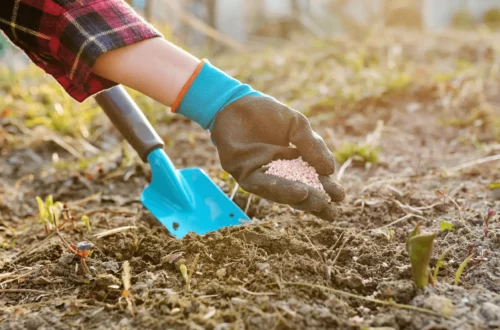Essential Steps for Preparing Soil for Blueberry Plants

Are you ready to dive into the world of blueberry gardening and unlock the secrets to preparing the perfect soil for these delicious berries? Imagine plucking handfuls of plump, juicy blueberries right from your backyard. With the right soil preparation, this dream can become your reality.
But where do you begin? Don’t worry, we’ve got you covered. In this guide, we’ll walk you through the essential steps for preparing soil for blueberry plants, ensuring optimal conditions for growth and a bountiful harvest.
Here’s a taste of what you can expect to learn:
1. The importance of soil acidity: Discover why the acidity level of your soil is crucial for blueberry cultivation and how to measure it accurately.
2. Enhancing soil fertility: Learn about organic soil amendments, such as peat moss and pine fines, that can improve the quality and structure of your soil.
3. Step-by-step soil preparation: Follow our expert tips and techniques for creating the perfect environment for blueberry plants, from soil testing to incorporating organic materials.
By the end of this guide, you’ll be armed with the knowledge and know-how to create an ideal growing environment for your blueberries. Get ready to enjoy the fruits of your labor like never before!
Introduction to Preparing Soil for Blueberries
Soil preparation is a crucial step for ensuring successful blueberry cultivation. By taking the time to understand the specific soil requirements of blueberry plants and following proper techniques, you can create an ideal growing environment that promotes healthy plants and bountiful harvests.
Proper soil preparation provides several benefits for blueberry gardening. Firstly, it helps create the right acidity levels that blueberry plants thrive in. Blueberries prefer acidic soil with a pH range of 4.5 to 5.5. Additionally, preparing the soil ensures the right organic matter content, which is essential for providing the necessary nutrients and promoting optimal root development.
By testing the soil, you can determine its current pH level and organic matter content and make necessary adjustments. This step helps determine if the soil is suitable for blueberry growth or if amendments are required.
Incorporating organic materials like peat moss and pine fines can greatly enhance soil structure, drainage, and nutrient retention—key factors in blueberry cultivation. These materials work to create an environment where blueberry roots can thrive and establish themselves effectively.
In the upcoming sections, we will dive deeper into each step of the soil preparation process, providing step-by-step instructions and expert tips for each component. By following these guidelines, you’ll be able to create the perfect soil conditions for your blueberry plants, setting them up for success.
Also read: The Ultimate Guide to Fertilizing Soil for Healthy Plant Growth
Step 1: Understanding Blueberry Soil Requirements
Blueberries have specific soil requirements that are crucial for their growth and productivity. Understanding these requirements is essential to ensure the success of your blueberry plants.
1. Acidity Levels: Blueberries thrive in acidic soil with a pH range of 4.5 to 5.5. This acidic environment enables the plants to absorb essential nutrients efficiently.
2. Organic Matter Content: Blueberries prefer well-drained soil rich in organic matter. Organic matter improves soil structure, promotes beneficial microbial activity, and enhances nutrient availability.
To meet these requirements, it is important to test the soil and make necessary adjustments to create an ideal growing environment for blueberries. This involves adjusting soil acidity using an espoma organic soil acidifier and incorporating organic materials, such as peat moss and pine fines, to improve soil quality and enhance nutrient retention.
By understanding and meeting the specific soil requirements of blueberry plants, you can provide them with the optimal conditions for healthy growth and abundant harvests.
Also read: The Ultimate Guide to Soil Preparation for Your Garden
Step 2: Testing the Soil
Before you start preparing the soil for your blueberry plants, it’s essential to test the soil to determine its suitability for blueberry growth. Follow these steps to obtain a soil sample and interpret the results:
1. Collecting the Soil Sample:
– Use a garden trowel to take multiple soil samples from different areas of your garden where you plan to grow blueberries.
– Take samples from a depth of 6-8 inches, as this represents the root zone of the blueberry plants.
– Combine the soil samples in a clean container and mix them thoroughly.
2. Testing the Soil:
– Take the soil sample to a reputable soil testing laboratory or use a DIY soil testing kit.
– Follow the instructions provided to test the soil pH and nutrient levels.
– Interpret the results to understand the soil’s acidity, nutrient deficiencies, and other characteristics.
By testing the soil, you can identify any issues that may hinder blueberry growth and make informed decisions about soil amendments and adjustments.
Step 3: Adjusting Soil Acidity
To ensure optimal growth and productivity of blueberry plants, it is crucial to adjust the soil acidity to the ideal range. One effective method to achieve this is by using an espoma organic soil acidifier, a trusted product for modifying soil pH levels.
Here’s how you can adjust soil acidity using an espoma organic soil acidifier:
1. Test the Soil: Before making any amendments, conduct a soil test to determine the current pH level. This will help you assess the extent of adjustment required.
2. Follow the Label Instructions: Consult the instructions provided on the espoma organic soil acidifier package. It will guide you on the appropriate application rate based on your soil pH test results.
3. Apply the Acidifier: Following the recommended guidelines, evenly distribute the acidifier over the targeted area. Incorporate it into the soil gently to ensure it reaches the root zone of the blueberry plants.
4. Monitor and Reapply: Regularly monitor the soil pH and adjust accordingly. Depending on the initial pH and desired range, you may need to reapply the espoma organic soil acidifier periodically.
Remember, maintaining the proper acidity level in the soil is critical for blueberry plants’ overall health and productivity. By following these steps, you can create an optimal growing environment for your blueberries.
Step 4: Incorporating Organic Materials
Incorporating organic materials into your blueberry soil is crucial for creating an optimal growing environment. Two highly beneficial organic materials for improving soil structure, drainage, and nutrient retention are peat moss and pine fines.
Benefits of Peat Moss:
– Peat moss enhances soil moisture retention, preventing it from becoming too dry or waterlogged.
– It also improves soil aeration, allowing roots to access oxygen more effectively.
– Peat moss helps in maintaining acidity levels required by blueberry plants.
Benefits of Pine Fines:
– Pine fines promote good soil structure by preventing compaction and improving drainage.
– They also provide a slow-release source of nutrients for the blueberry plants.
– Pine fines help acidify the soil, creating favorable conditions for blueberries.
To incorporate these organic materials, mix them evenly into the existing soil. Aim for a ratio of approximately 50% peat moss and 50% pine fines. This blend will enhance the soil quality and create an ideal environment for the growth of your blueberry plants.
Also read: The Ultimate Guide to Making Organic Soil for a Healthy Vegetable Garden
Step 5: Mixing Pine Fines and Peat Moss
To create the ideal blueberry soil blend, follow these step-by-step instructions:
1. Measure the amount of soil needed based on the size of your blueberry planting area. A general rule is to have 1/3 organic matter, such as pine fines and peat moss, to 2/3 existing soil.
2. Calculate the required amount of pine fines and peat moss based on the measurements. For example, if you have 9 cubic feet of soil, you will need 3 cubic feet of organic matter.
3. In a large container or wheelbarrow, mix the pine fines and peat moss together. Start with equal parts and adjust the ratio to achieve the desired acidity level, aiming for a pH range of 4.5 to 5.5.
4. Thoroughly blend the organic matter and soil together using a garden fork or shovel. This will ensure even distribution and a homogenous mixture.
5. Once mixed, the blueberry soil blend is ready to be used. Gently incorporate it into the planting area, making sure the roots of the blueberry plants are in direct contact with the mixture.
Remember to handle the pine fines and peat moss with care, as these organic materials are essential for creating the right growing conditions for blueberries. By achieving the perfect balance of pine fines and peat moss, you can provide the ideal soil environment for healthy and productive blueberry plants.
Also read: The Ultimate Guide to Preparing Soil for Sod Installation
Key Takeaways
Preparing the soil is a crucial step for successful blueberry gardening. By following the proper techniques, you can create an ideal growing environment for your blueberry plants, ensuring healthy growth and abundant harvests. Here are the key points to remember:
1. Understand Blueberry Soil Requirements: Blueberries thrive in acidic soil with a pH range of 4.5 to 5.5. It’s essential to ensure the right acidity level for optimal growth and nutrient absorption.
2. Test the Soil: Before planting, conduct a soil test to assess its suitability for blueberry cultivation. Interpret the results to determine any necessary amendments for pH adjustment and nutrient deficiencies.
3. Adjust Soil Acidity: Use an Espoma organic soil acidifier to lower the pH of alkaline soil. Follow the recommended application rates and provide direct contact between the acidifier and the roots of the blueberry plants.
4. Incorporate Organic Materials: Improve soil structure, drainage, and nutrient retention by adding peat moss and pine fines. These organic materials help create a favorable environment for blueberries.
5. Mix Pine Fines and Peat Moss: Combine the appropriate proportions of pine fines and peat moss to create a well-balanced blueberry soil blend. This mixture enhances acidity, moisture retention, and nutrient availability.
Also read: The Ultimate Guide to Preparing Soil for Grass Seed
Proper soil preparation is the foundation for successful blueberry gardening. By following these steps and using the recommended organic materials, you can create the optimal conditions for your blueberry plants to thrive. Happy gardening!





